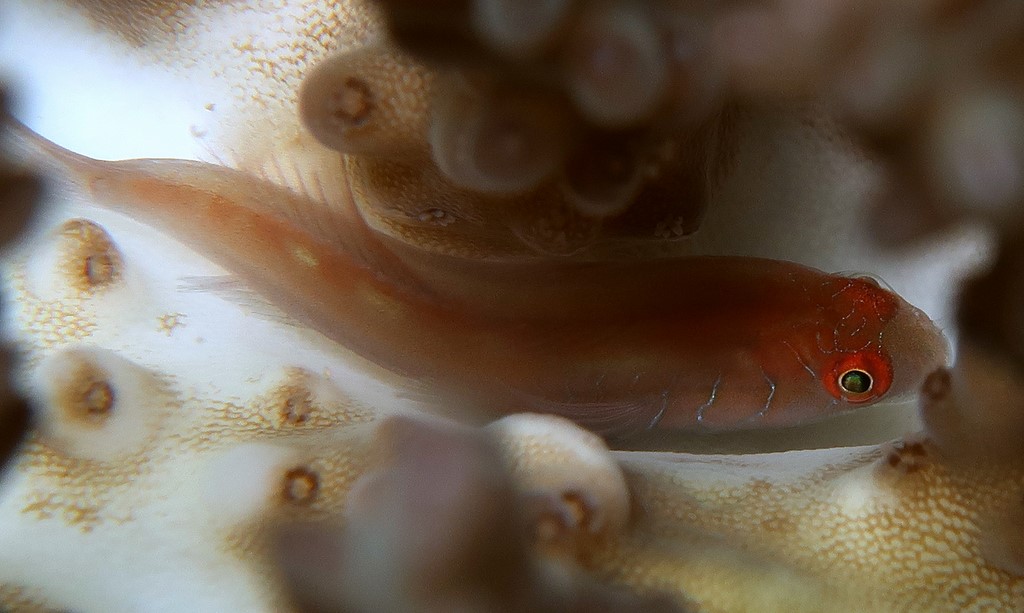GOBIODON PROLIXUS - (WINTERBOTTOM & HAROLD, 2005)
Picture courtesy of: Alain Daoulas
Actinopterygii (Gigaclass) > Actinopteri (Class) > Teleostei (Subclass) > Gobiiformes (Order) > Gobioidei (Suborder) > Gobiidae (Family) > Gobiinae (Subfamily) > Gobiodon (Genus)
Elongate coralgoby, Awairokobanhaze, アワイロコバンハゼ,
Distribution
Dorsal spines (total): 7; Dorsal soft rays (total): 10; Anal spines: 1; Anal soft rays: 8. A slim to somewhat tubular body shape, especially in adults (body depth at pelvic-spine origin 28-36 % SL; Distance between the anterior base of the first dorsal-fin spine and the anterodorsal base of the first pectoral - fin ray 41.3-50.4% HL); A short straight groove may be present between the medial margin of the interopercle and the isthmus, but its presence or absence seems to depend on position of suspensorium when preserved. Max. length: 3.2 cm SL. Depth range: 0 - 21 m.
Color
Adults and juveniles translucent greenish grey; Five vertical blue lines on the head and pectoral-fin base in juveniles and adults; Ovate internal bluish grey spots along vertebral column.
Etymology
Gobiodon: from Latin, gobius = gudgeon + from Greek, odous = teeth. Referring to pair of posterior canines near symphysis of lower jaw of Gobiodon heterospilos.
prolixus: from Latin, prōlixus = stretched out, extended. Referring to its more elongate body compared to congeners.
Original description: Gobiodon prolixus Winterbottom & Harold, 2005 - Type locality: Southeastern side of Hon Mot Island, 12°10'38.8"N, 109°16'14.2"E, Nha Trang, Vietnam, depth 0-5 meters.
Distribution
Red Sea, Indo-West Pacific: Comoros, Madagascar and Rodrigues (Mascarenes) east to Australia, New Caledonia and Tuamotu Islands; East Indian region.
Biology
Facultative air-breathing in the genus; A coral-commensal species. Capable of changing sex during their life. Remarkably, they can change sex in both directions, from male to female (protandrous), and from female to male (protogynous).
Similar species
Gobiodon quinquestrigatus (Valenciennes, 1837) - Reported from Eastern Indian Ocean, western Pacific: eastern Malaya (Malaysia) and Indonesia east to Philippines and Society Islands, north to Japan, south to northern Australia.
Gobiodon rivulatus (Rüppell, 1830) - Reported from New Caledonia.
Last update: 19, November 2022
Actinopterygii (Gigaclass) > Actinopteri (Class) > Teleostei (Subclass) > Gobiiformes (Order) > Gobioidei (Suborder) > Gobiidae (Family) > Gobiinae (Subfamily) > Gobiodon (Genus)
Elongate coralgoby, Awairokobanhaze, アワイロコバンハゼ,
Distribution
Dorsal spines (total): 7; Dorsal soft rays (total): 10; Anal spines: 1; Anal soft rays: 8. A slim to somewhat tubular body shape, especially in adults (body depth at pelvic-spine origin 28-36 % SL; Distance between the anterior base of the first dorsal-fin spine and the anterodorsal base of the first pectoral - fin ray 41.3-50.4% HL); A short straight groove may be present between the medial margin of the interopercle and the isthmus, but its presence or absence seems to depend on position of suspensorium when preserved. Max. length: 3.2 cm SL. Depth range: 0 - 21 m.
Color
Adults and juveniles translucent greenish grey; Five vertical blue lines on the head and pectoral-fin base in juveniles and adults; Ovate internal bluish grey spots along vertebral column.
Etymology
Gobiodon: from Latin, gobius = gudgeon + from Greek, odous = teeth. Referring to pair of posterior canines near symphysis of lower jaw of Gobiodon heterospilos.
prolixus: from Latin, prōlixus = stretched out, extended. Referring to its more elongate body compared to congeners.
Original description: Gobiodon prolixus Winterbottom & Harold, 2005 - Type locality: Southeastern side of Hon Mot Island, 12°10'38.8"N, 109°16'14.2"E, Nha Trang, Vietnam, depth 0-5 meters.
Distribution
Red Sea, Indo-West Pacific: Comoros, Madagascar and Rodrigues (Mascarenes) east to Australia, New Caledonia and Tuamotu Islands; East Indian region.
Biology
Facultative air-breathing in the genus; A coral-commensal species. Capable of changing sex during their life. Remarkably, they can change sex in both directions, from male to female (protandrous), and from female to male (protogynous).
Similar species
Gobiodon quinquestrigatus (Valenciennes, 1837) - Reported from Eastern Indian Ocean, western Pacific: eastern Malaya (Malaysia) and Indonesia east to Philippines and Society Islands, north to Japan, south to northern Australia.
Gobiodon rivulatus (Rüppell, 1830) - Reported from New Caledonia.
Last update: 19, November 2022
